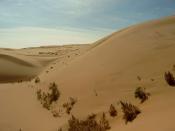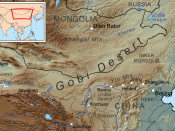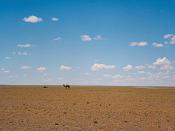The Gobi Desert, the most recognized desert of Asia, is also one of the largest deserts in the world. Nomadic herdsmen sustain life in the severe conditions through grazing animals, and require horses especially to travel. Although now converging with more Western styles of life, these people in their survival in the desert are still preserving customs from long ago when their ancestors were part of the great Mongol Empire. They are an amazing group of people, doing all they can to survive in such a harsh environment: the Gobi Desert.
LOCATION
The Gobi desert is found in Central Asia, in the southern parts of Mongolia, and in the northern parts of China. It is to the north of the Himalayan Mountains, and over 1000 kilometres from any ocean. As a desert, the Gobi does not have strict boundaries, although the land stretches from 37 North to 46 North (around 9700 kilometres), and 93 East to 118 30" East (approximately 1610 kilometres).
This huge land of over 1,300,000 square kilometers is the coldest, most northern desert in the world. In Mongolia, the provinces of East Gobi, Middle Gobi, South Gobi and Gobi Altai are each covered by the great desert. It is mainly made up of a large plateau bordered by many mountain ranges, and consists of relatively little sand, many grassy plains, dry, rocky soil, and heights of 914 metres to 1524 metres above sea level at the eastern and western extremities. Mountain ranges, steppe lands and rolling hills, often as a result of faulting action, can however be higher than this. In the Gobi can be found a wide variety of landforms, which are a contrast to the sandy deserts of Africa.
TRADITIONAL OWNERS / OCCUPANTS
Nomadic tribes of horsemen have inhabited the Gobi Desert...


